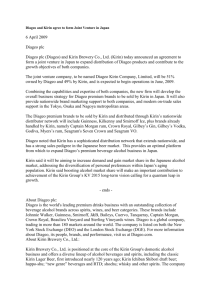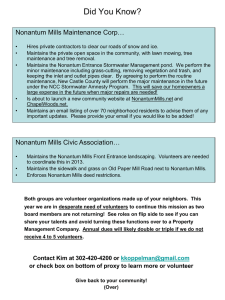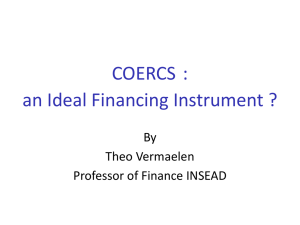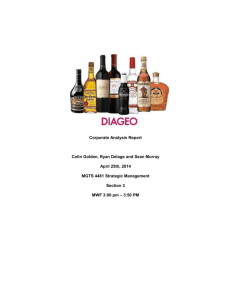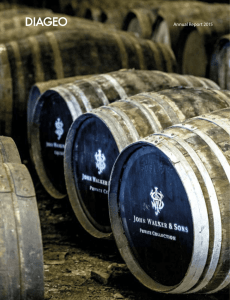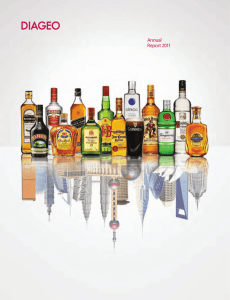About General Mills - Tabitha Foundation Cambodia
advertisement
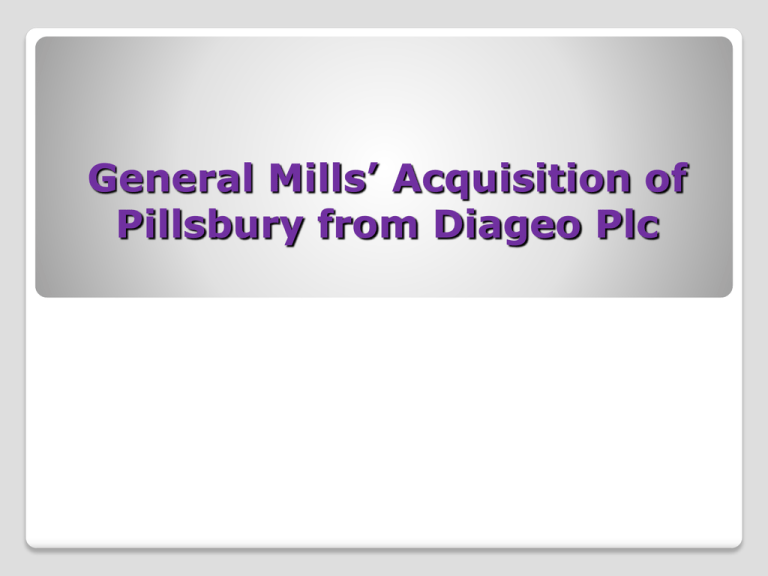
General Mills’ Acquisition of
Pillsbury from Diageo Plc
Outlines
Background of the transaction
Companies’ profile
◦ About General Mills
◦ About Pillsbury and Diageo Plc
Features of the transaction
Motives for General Mills
Terms of transaction
Recommendation to shareholders
2
Background of the transaction
July 2000: GM’s management agreed to buy Pillsbury from
Diageo Plc.
8 December 2000: GM’s Management recommended its
shareholders to approve the proposed acquisition.
Transaction in the form of exchange of shares of GM
(Diageo becomes GM’s major shareholder).
Before the transaction, Pillsbury would borrow $5 billion
and pay a special dividend to Diageo.
GM would receive contingent payment up to $642 million
from Diageo in one year after the transaction.
3
This contingent payment puzzled GM’s
shareholders:
Would
this deal create value for GM’s
shareholders?
Should
GM’s shareholders approve this
transaction?
4
About General Mills
General Mills started in 1866 as a flour
company in Minneapolis Minnesota.
General Mills produces mostly yogurt and
cereal.
A study showed that at every American
has at least one GM product when they go
grocery shopping.
GM had annual revenues of about $7.5
billion in the year 2000.
5
Products
Boo Berry, Count Chocula, Cocoa Puffs,
Cinnamon Toast Crunch, Franken Berry,
Cheerios, Lucky Charms, Trix, Wheaties,
and Reese’s Puffs.
6
Location
General Mills is located in Golden Valley,
Minnesota outside of Minneapolis. General
Mills was founded in 1866.
GM’s products are manufactured in 15
countries and are available in more than
100 countries.
7
Competition
Although highly profitable, GM is facing
increased competition in the food industry.
Two major competitors of General Mills are
Kellogg’s and Post. Both companies make
cereal.
8
About Pillsbury and Diageo
Pillsbury has been well knew in food industry.
Diageo is a London-based consumer-goods
conglomerate that specializes in the manufacture
of premium alcoholic brands such as Smirnoff,
Johnnie Walker, and Guinness.
Diageo’s portfolio includes world-famous drink
brands, Burger King, and Pillsbury, a producer of
refrigerated dough and baked goods.
Pillsbury is one of America’s best-recognized
names in the food industry.
9
About Pillsbury and Diageo
Pillsbury has successfully positioned its brand and
been longstanding for success in the food industry.
Pillsbury controls several other high-profile brands,
such as Green Giant, Old El Paso, and Progresso.
Not too far behind General Mills, in 2000, Pillsbury
generated annual revenues of $6.1 billion.
Although Pillsbury has shown a high potential for
growth in the food industry, Diageo PLC hopes to
divest the company in order to focus more on its
core alcoholic beverages business.
10
About Pillsbury and Diageo
In recent years, its beer and liquor businesses
have been strong performers, yet its Pillsbury
and Burger King divisions have been a drag on
earnings.
Thus, a deal with General Mills will allow Diageo
to divest some of its unprofitable food assets and
will also enable Diageo to focus more heavily on
its thriving alcohol business.
11
Features of the transaction
Transaction involves a stock-for-stock exchange that would pay Diageo over
$10 billion: distributed to Diageo as a special dividend before the deal is
closed.
Equivalent to 1/3 of total GM shares
(141 million shares of common stock + $5.142 billion in debt)
($142 million of existing debt + $5 billion in new borrowings)
Deal worth
over
$10 billion
141 million
shares of
common stock
$5.142 billion
of debt
$5 billion
new borrowing
$142 million
existing debt
12
Features of the transaction
After the transaction, Diageo will own 33% of GM’s outstanding shares, and
Pillsbury operating as a wholly-owned subsidiary of GM.
This means that Pillsbury is completely controlled by GM, and Diageo is
primarily divesting its holding in Pillsbury in exchange for a substantial
holding in General Mills.
General Mills
General Mills
Diageo’s
holding 1/3 of
GM’s shares
Pillsbury
Pillsbury
Diageo
Diageo
Before the deal
After the deal
13
The transaction also includes a rare contingency payment,
which specifies that $642 million of the transaction cost will
be set aside by Diageo for one year following the closing of
the deal.
◦ If GM’s 20-day average stock price is above $42.55,
Diageo is to transfer the $642 million back to GM.
◦ If average stock price is below $38, Diageo will pay
$450,000.
◦ If stock price falls in between, the fund will be split on a
pro-rated basis.
Two main constraints: First, GM does not want Diageo to
own more than 1/3 of its stock. Second, GM does not want
to lose its investment-grade bond rating of A-.
14
Motives for General Mills
Diversification: General Mills is motivated to acquire
Pillsbury because Pillsbury has a strong presence in the
food-service industry, successfully serving restaurants,
school cafeterias, and vending machines that meet its
desire to grow and expand, and to remain a market leader
and survive against heavy competition.
Growth: The acquisition gives GM the opportunity to
double the size of its empire, becomes more powerful in
supermarket aisles. If the acquisition is approved, GM will
have more than 30 brands with annual sales exceeding
$100 million (GM Annual Report, 2000).
15
Synergy: GM’s management believe that the two
companies will grow faster together. In other words, GM
hopes to increase the value of the combined enterprise
through synergy, which will benefit Diageo as well as the
other GM’s shareholders.
This synergy is achieved through newfound economies of
scope and a reduction in competitive forces. It will be able
to combine the capital, resources, and technology of both
firms, resulting in greater efficiencies.
Strong global presence: By combining the two
companies, sales of General Mills’ brands in international
markets will more than double and add almost $1 billion in
revenues from Pillsbury operations in Asia, Europe, and
Latin America.
16
Industry force: Competition in food industry has been
more intent. In order to keep pace with industry rivals, GM
must expand in order to give itself more power over shelf
space and pricing decisions.
GM’s cereal division (its core business) has shown declining
sales. Therefore, if GM acquires Pillsbury, it is able to
drastically reduce its dependence on cereal sales and focus
on more profitable divisions.
17
Cost savings:
GM’s management believes that if Pillsbury is acquired, it will
attain pretax savings of $25 million, $220 million, and $400
million in 2000, 2001, and 2003 respectively.
We use WACC (weighted average cost of capital) to compute
for interest rates (8.14%), applied in the calculation of NPV
of these pretax savings:
NPV (8.14,0,{25,220,400}) = $527.55 million
However, through the synergies of GM and Pillsbury, we
believe that the cost savings will last longer than three
years; therefore, the NPV of pretax savings will be much
higher than $527.55 million.
18
Terms of the transaction
Payment of shares:
GM would issue 141 million shares of common stock to
Diageo (33% of GM’s total outstanding shares. In July 2000,
GM’s stock traded at around $34 - $37. By December, its
stock traded at around $40 - $42.
Assumption of Pillsbury debt:
At the closing of the deal, GM agreed to assume the
liabilities of Pillsbury an amount of $5.142 billion of debt:
($142 million in existing debt + $5 billion in new borrowing)
19
Contingent payment by Diageo to GM: at the closing,
Diageo would establish an escrow fund of $642 million,
which Diageo would pay to GM a certain amount depending
on GMs’ share price:
◦ $642 million, if average daily share price for 20 days was
$42.55 or more.
◦ $0.45 million, if the average daily share price for 20 days
was $38 or less.
◦ Variable amount, if the average daily share price for 20
days was between $38 and $42.55.
Some financial analysts called this a ‘claw-back’ provision,
while others called this a ‘contingent value right’ (CVR).
Merrill Lynch estimated that the transaction costs, borne by
GM, for this deal would amount to $55 million.
20
Recommendation to shareholders
The acquisition is expected to produce pre-tax
cost savings of $527.55 million. This indicates
that there is positive synergy between GM and
Pillsbury.
Based on the analyses by Meryl Lynch and
Evercore Partners, Pillsbury is worth between
$11.836 - $13.489 billion and $11.3 - $14.2
billion respectively.
Thus, acquiring Pillsbury will add a significant
amount of value to GM.
21
Recommendation to shareholders
Furthermore, since GM strongly believes that its
stock price will rise post-acquisition, the stock
price at GM may rise well above $42.55, thus
increasing GM’s value further. They will gain back
$641.55 million.
This deal is absolutely economically attractive
from the viewpoint of GM’s shareholders.
Therefore, it is recommended that GM’s
shareholders should approve the deal.
22
Thank you for your
kind attention!
23
Computing for interest rates, used for
calculating NPV of pretax savings
Cost Savings: To numerically illustrate the benefits
associated with the acquisition, we calculated the present
value of the cost savings that would result from the
acquisition. In order to compute this number, we first had to
determine the applicable interest rate to use. We agreed
that WACC is the best rate to use, as it is a reliable
benchmark indicator.
Cost of Debt: We used the prime rate of 9.5% for the cost
of debt, as this is the interest rate that banks charge its
most creditworthy customers. GM is considered a
creditworthy company because it is classified as a large cap
organization.
24
Cost of Equity: To formulate the cost of equity, we used the
CAPM model. We decided to use the expected market rate
of the S&P 500, as GM is a large cap company and the S&P
500 shows the average performance of the top 500 large
cap companies. We decided to use the 2-year annual return
of 1999 & 2000. If we had used the 1, 5, or 10-year yields,
we would have arrived at ludicrous expected returns. For
example, the 1-year rate yielded negative results, whereas
the 5 and 10-year rates yielded results that were too high to
incorporate into our calculation.
𝑅𝑒=𝑅𝑓+𝑏 (𝑅𝑚−𝑅𝑓) =5.74+.65 11.94−5.74 =9.735%
Re: estimated interest rate
Rf: risk-free interest rate
Rm: market interest rate
25
Weight of Debt & Equity: To determine the appropriate debt
and equity weights, we used GM’s 20 day average stock
price on November 27, 2000, which was $40.43. We also
know that General Mills is offering Diageo 141 million shares
for Pillsbury, which would make Diageo one of General Mills’
major shareholders. In fact, Diageo will own 1/3 of the total
company. Therefore, we can calculate the total number of
shares that GM has outstanding.
141∗3=423 𝑚𝑖𝑙𝑙𝑖𝑜𝑛 𝑠h𝑎𝑟𝑒𝑠 𝑜𝑟 .423 𝑏𝑖𝑙𝑙𝑖𝑜𝑛 𝑠h𝑎𝑟𝑒𝑠
423 – 141 = 282 million shares or .282 billion shares before
issuing new shares 40.43∗.282=$11.4 𝑏𝑖𝑙𝑙𝑖𝑜𝑛
* $40.43 is the 20 day average price on November 27, 2000
As of November 27, 2000, General Mills’ estimated market
capitalization is $11.4 billion.
26
GM’s long-term debt-to-equity ratio is estimated to be about
6.719%. Since we know both its long-term debt-to-equity
ratio as well as its estimated market capitalization, we can
now determine how much long-term debt General Mills has.
.06719=𝐷/𝐸=𝐷/11.4
𝐷=.766=0.766 𝑏𝑖𝑙𝑙𝑖𝑜𝑛
By using its current market capitalization of $11.4 billion
and its long term debt of $0.766 billion, the weight of debt
comes out to be 6.72%.
𝑊𝑒𝑖𝑔h𝑡 𝑜𝑓 𝐷𝑒𝑏𝑡=𝐷/𝑉=.766/(11.4+.766)=𝟔.𝟑%
𝑊𝑒𝑖𝑔h𝑡 𝑜𝑓 𝐸𝑞𝑢𝑖𝑡𝑦=𝐸/𝑉=(11.4−.766)/(11.4+.766)=𝟗𝟑.𝟕%
𝑊𝐴𝐶𝐶= 𝐸/𝑉 ∗𝑅𝑒 + 𝐷/𝑉 ∗𝑅𝑑∗ (1−𝑇)
𝑊𝐴𝐶𝐶= (.937) (9.735) + (.63) ∗9.5 (1−.35)
𝑾𝑨𝑪𝑪=𝟏𝟑.𝟎𝟏%
Re: Cost of equity/ Rd : Cost of Debt
27
With the additional $5.142 billion in debt, the WACC
changes as follows:
𝑊𝑒𝑖𝑔h𝑡 𝑜𝑓 𝐷𝑒𝑏𝑡=𝐷/𝑉=(.766+5.142)/(12.17+5.142)=𝟑𝟒.𝟏𝟑%
𝑊𝑒𝑖𝑔h𝑡 𝑜𝑓 𝐸𝑞𝑢𝑖𝑡𝑦=𝐸/𝑉=(16.542−5.908)/17.31=𝟔𝟏.𝟒𝟑%
Modigliani & Miller Proposition II:
𝑅𝑒′=𝑅𝑜+ (𝐷/𝐸) (𝑅𝑜−𝑅𝑑) (1−𝑇)
𝑅𝑒′=9.735+ (5.908/10.634) (9.735−9.5) (1−.35) =𝟗.𝟖𝟐%
The cost of equity increased because General Mills is taking
on more debt, thus its exposure to bankruptcy subsequently
increases. Due to this increased risk, investors will require a
higher rate of return (which can be seen in the new
calculation for the cost of equity).
𝑊𝐴𝐶𝐶= 𝐸/𝑉 ∗𝑅𝑒+ 𝐷/𝑉 ∗𝑅𝑑∗ (1−𝑇)
𝑊𝐴𝐶𝐶= (.6143) (9.82) + (.3413) ∗9.5 (1−.35)
𝑾𝑨𝑪𝑪=𝟖.𝟏𝟒%
Back to slide # 18
28

